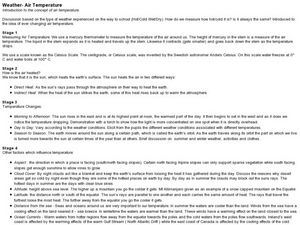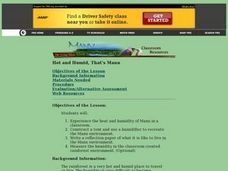Curated OER
Warm and Cold Air
Students conduct an experiment to discover what happens to air when it is heated or cooled, discover that wind moves from a high-pressure area (an area of sinking air) to a low pressure area (an area of rising air).
Curated OER
Warm Air versus Cold Air
Students discover that warm air takes up more space than cold air. In this science lesson, students perform 4 experiments using balloons to determine that the molecules of warm air are more spread out than those of cold air.
Curated OER
Hot and Cold Air
In this hot and cold water worksheet, students use hot and cold water to experiment and see what happens when the two mix together. Students also answer 7 questions.
Curated OER
Temperature and the Density of Air
Here is a hands-on activity in which junior scientists put air into a balloon to create a closed system. They measure its circumference, warm it in hot water, and then remeasure its circumference to discover how temperature affects the...
Constitutional Rights Foundation
The Cold War: How Did It Start? How Did It End?
What is the difference between a Cold War and a Hot War? Scholars research the beginning of the Cold War. They analyze diary entries as well as excerpts from various events during the 45-year standoff. To finish, they prepare final...
Curated OER
Weather Fronts: Understanding the Movement of Air
Students study various types of weather fronts and what happens to air at different temperatures. In this investigative activity students draw various weather fronts and show the movement of the air then they observe demonstrations of...
Colorado State University
If Hot Air Rises, Why Is it Cold in the Mountains?
Investigate the relationship between temperature and pressure. Learners change the pressure of a sample of air and monitor its temperature. They learn that as air decreases its pressure, its thermal energy converts to kinetic energy.
Discovery Education
Smoke on the Water
How do clouds form? Learners demonstrate the formation of clouds and the water cycle by testing four different setups in a plastic bottle. They identify the key components of a cloud to help them understand the process of cloud...
American Chemical Society
Keeping Warm in the Cold
Bundle up to stay warm! A fun-filled investigation opens with a group discussion about heat loss and using materials to prevent it. Young scientists then view an animation about thermometers and the Celsius scale and practice reading...
Curated OER
Warm and Cold Front Foldable
In this warm and cold front worksheet, students fill in a Venn diagram relating cold and warm fronts, they read and observe pictures of cold and warm fronts and they answer questions about warm and cold fronts.
NOAA
Climate, Weather…What’s the Difference?: Make an Electronic Temperature Sensor
What's the best way to record temperature over a long period of time? Scholars learn about collection of weather and temperature data by building thermistors in the fourth installment of the 10-part Discover Your Changing World series....
Curated OER
Rising Air
Students investigate the concept of rising air in the formation of clouds and precipitation. In this rising air lesson, students conduct an experiment with hot and cold water that shows how warm water rises due to thermal buoyancy. They...
Curated OER
Movement of Air
In this movement of air worksheet, students identify and describe the purpose for convection and how it effects Earth. Then they describe what thermals are and why they occur in hot and cold air movements. Students also explain why...
Curated OER
The Cloud Case
Learners discover how clouds form and how air pressure and air temperature affect their formation. The instructional activity is delivered in the story of Mike Breezy, Air Detective, who tries to solve The Cloud Case.
Bonneville
Where Does Energy Go?
Convection currents aren't just a bunch of hot air. The second of five lessons in the Solar Updraft Towers unit focuses on energy transfer and convection currents. Young scientists watch six demonstrations that illustrate how warm air...
Curated OER
Snake Spiral
In this convection currents worksheet, learners draw, cut and decorate a spiral snake on a sheet of paper. Students attach a piece of thread to its head and hang it over a hot radiator and watch the snake spin as the warm air rises.
Curated OER
Hot air Balloons
Students study how hot air balloons were created and the different types there are. In this density and lift lesson students build their own hot air balloon.
Curated OER
Weather-Air Temperature
Students complete activities to learn about changing air temperature. In this air temperature lesson, students study various ways to measure air temperature and learn factors that influence temperature. Students study the weather in a...
Curated OER
Shrinking Air
In this science investigation activity, students follow the listed procedures to find out how temperature affects air pressure as they heat and cool balloons.
Curated OER
Hot n' Cold
Students keep a weather log. In this weather and temperature instructional activity, students discuss the information that can be obtained from a map and lead into a discussion about temperature. Students watch a video about temperature...
American Chemical Society
Changing State: Condensation
When you have a cold drink and you notice the water forming on the outside, it is literally pulling the water from the surrounding air to form the condensation. After watching a demonstration of condensation forming on a glass,...
Curated OER
Hot and Humid, That's Manu
Elementary and middle schoolers participate in a demonstration of the heat and humidity of the Manu rainforest environment. They watch and discuss a video, calculate the humidity and temperature in the humidified tent, and write a...
Colorado State University
Can Gravity Push Something Up?
How does a hot air balloon fly? An experimental lesson has scholars build a balloon from a garbage bag and monitor the movement of air. As the temperature of the air in the balloon increases, gravity moves the denser cool air down,...
Curated OER
Measuring Temperatures
Fourth graders participate in a teacher-led discussion about temperature--hot and cold. Each group of students is assigned specific materials for their lab experiment. They record temperatures measured in their journals and then plot...

























